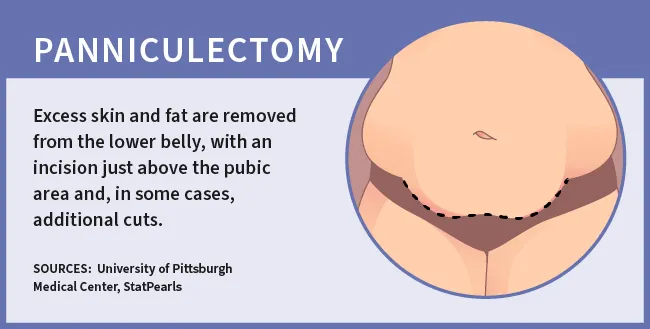What Is Panniculectomy?
A panniculectomy is surgery to remove excess hanging skin and fat, called a pannus or apron, from the lower belly. It's often done after a big weight loss when the stretched skin may hang over your genitals or extend to your thighs or beyond.
Some doctors call it a lower abdomen lift.
If you're bothered by how an apron belly looks, a panniculectomy may help you feel better about your body. It can also have health benefits. It isn’t a tummy tuck (abdominoplasty), which is a different procedure done for cosmetic reasons.

Why Get a Panniculectomy?
You might consider a panniculectomy if you have an apron belly because of body changes caused by:
- A big weight loss, such as after weight loss surgery
- Age
- Pregnancy
- Prior procedures, such as liposuction
The excess skin of a pannus stomach can hang over your genital area or thighs, or go as low as your knees, interfering with daily activities such as walking, standing, and sitting.
The area beneath the skin can be hard to keep clean. Removing it can lower your chance of skin infections, rashes, and sores. If the appearance bothers you, getting the surgery might give you more confidence.
Not everyone who has an apron belly is a good candidate for a panniculectomy. Your doctor is more likely to recommend it if:
- You're pretty healthy, with no uncontrolled heart disease, lung disease, or diabetes.
- You're a nonsmoker, as cigarettes affect blood supply and wound healing.
- Your overhanging skin interferes with your daily activities.
- Your weight has been stable for six months or more.
- You're at least 18 months past any weight loss surgery.
- You have symptoms such as persistent rashes or infections in the area underneath the hanging skin.
Panniculectomy isn't used as a treatment for obesity.
Panniculectomy vs. tummy tuck
In a tummy tuck, or abdominoplasty, a surgeon removes excess skin and fat from your abdomen and also smooths and flattens the stomach by tightening muscles.
In a panniculectomy, there's no tightening of your muscles.
While a tummy tuck is considered a cosmetic procedure — done for nonmedical reasons — a panniculectomy is not.
Panniculectomy vs. body contouring
Body contouring is a general term used to describe several procedures, including panniculectomy, that lift or remove skin to change the shape and contour (outline) of a body area. Other body contouring procedures include tummy tucks, face lifts, breast lifts, and buttock lifts. Sometimes, more than one of these surgeries is done at the same time.
Panniculectomy Complications
Before you get a panniculectomy, you should discuss possible risks and complications with your surgeon.
Risks during and immediately after surgery could include:
- Reactions to medicines
- Breathing problems
- Bleeding
- Blood clots
- Infection
Later risks and complications could include:
- Fluid buildup under the skin (seroma)
- Poor healing of the skin
- Skin loss and scarring
- Tissue death
- Prolonged swelling
- Nerve damage that may affect your sense of touch
- Lasting pain
- Return of loose skin
- Skin discoloration
- Infection
Preparing for a Panniculectomy
When preparing for panniculectomy surgery:
Be open about your medical history. Let the surgery team know if you are taking any prescription or over-the-counter medicines.
Beware of certain medications. Your surgeon may suggest that you avoid taking herbal supplements and anti-inflammatory drugs, which may increase bleeding and make it hard for your blood to clot.
Avoid smoking. If you smoke, your surgeon may ask you to stop smoking to increase your chances of healing fast. Smoking slows down wound healing.
Panniculectomy Procedure
The procedure involves:
Anesthesia. You will get medication to make sure you are asleep, at ease, and don’t feel pain during the procedure. Your surgeon will suggest the best choice for you.
Incision. A panniculectomy requires a long incision in your lower belly, just above your pubic area. In some situations, if you have a lot of skin on your sides, you may also need an up-and-down (vertical) incision. You might also need a cut around your belly button.
Removing skin and fat. The surgeon snips away the apron of excess skin and the layer of fat just below it.
Finishing the surgery. The remaining skin from the upper abdomen is pulled down like a window shade. If needed, your belly button is put into its new position. The surgeon uses stitches, tape, or clips to close the cuts. Small tubes called drains might be inserted in the wound to let blood or fluids drain out. You'll get a dressing to cover the area.
Patients with a very large amount of overlapping skin and fat may need more procedures.
Panniculectomy Recovery
After your surgery, expect to have some pain and swelling. Your doctor will give you painkillers to use for the first few days. After a day or so, you'll also get a girdle-like garment to wear for extra support.
You might have numbness in the surgical area, see bruises, and be especially tired for a while. That's normal. Here's what to expect in the days and weeks ahead.
Panniculectomy recovery time
Hospital stay. You might stay in the hospital for a couple of days after the surgery. It could be longer if your surgery was complex.
Resting at home. If you work, expect to take up to four weeks off, depending on how you feel and the kind of work you do. Don't do anything strenuous for four to six weeks.
Full recovery. It takes about three months for the swelling to go away and your wounds to heal fully. But it can take longer, up to two years, for scars to fade and for the final results of your surgery to become clear.
Panniculectomy recovery tips
Here are some ways to ease recovery and avoid complications:
- Hold a pillow over your incisions when you cough or take deep breaths.
- Wash the area daily with warm water, but don't use hydrogen peroxide or alcohol.
- Ask your doctor if you should sleep in a recliner or propped up in bed, with pillows under your knees, to reduce strain on your abdomen.
- Avoid constipation and straining to poop. Use a stool softener or laxative if recommended by your doctor.
Always follow your surgeon’s instructions on how to take care of yourself and when to call for advice. Seek immediate medical attention if you notice shortness of breath, unusual heartbeats, or chest pain when you are home.
Is Panniculectomy Covered by Insurance?
In many cases, it is. Insurers differ, but coverage may be more likely if you have medical problems caused by your pannus stomach. Those could include skin problems, such as infections and rashes, as well as problems with walking and other daily activities. Insurers also tend to cover panniculectomy after weight loss surgery. Check with your insurer before scheduling the surgery.
What Happens if You Gain Weight After a Panniculectomy?
It's normal to gain some weight over time after your procedure. One small study found an average 4% weight gain over 12 years in people who had panniculectomies or tummy tucks after weight loss surgery. But if you regain a lot of weight and then lose it again, your skin may stretch again. It may also affect your overall health.
Takeaways
If you have an apron of excess skin and fat hanging from your belly after a big weight loss, or for other reasons, you might be a candidate for a panniculectomy. This surgery isn't for everyone with an apron belly. Your doctor is most likely to recommend it if the excess flesh is interfering with your everyday activities or causing health problems, such as rashes and infections.
Panniculectomy FAQs
How much does a panniculectomy cost?
Costs vary depending on your surgeon, location, and especially your insurance coverage. Surgery practices that report price ranges show costs, before insurance, ranging from about $8,000 to $15,000.
Can you get a panniculectomy without weight loss?
There might be cases in which you can get a panniculectomy without weight loss. However, the surgery is most often recommended and covered by insurers when you've lost a lot of weight and have an apron belly, causing you health problems. Doctors are unlikely to recommend it if your weight isn't stable or you plan to lose significant weight in the future. If you want the surgery for appearance reasons rather than health reasons, it will be considered a cosmetic procedure, and insurers won't pay. There's no specific weight you need to reach to qualify for the surgery, but having a higher body mass index (BMI) can put you at risk for more complications.
Is a panniculectomy safe?
Every surgery has risks, including bleeding and infection, and panniculectomy is no exception. It also carries some risks of long-term complications. These risks vary depending on your health and other factors. Studies show complication rates ranging from about 8% to over 50%. So, talk to your surgeon about your risks.


